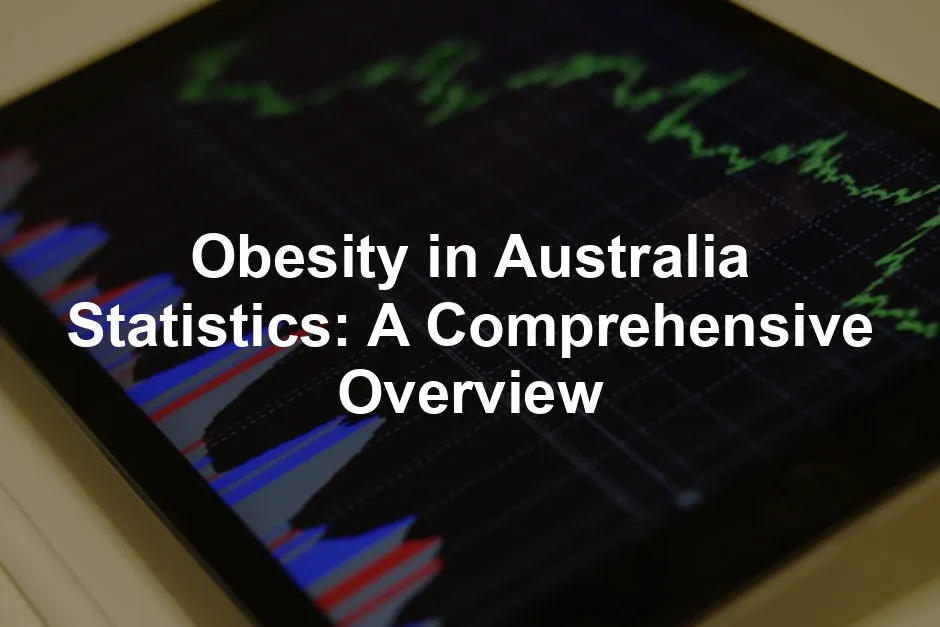Introduction
Obesity is a serious health condition defined by excessive body fat. In Australia, it has reached alarming proportions, impacting millions. According to the Australian Institute of Health and Welfare, obesity is one of the leading contributors to preventable chronic diseases. Health issues such as diabetes, heart disease, and certain cancers are closely linked to this epidemic.
Understanding obesity statistics is vital. For policymakers, they guide public health initiatives and funding. Healthcare providers can tailor interventions based on these insights. The general public benefits from awareness, promoting healthier lifestyle choices.
This article will provide a detailed overview of obesity in Australia, highlighting prevalence rates among various demographics. We will analyze trends over time and discuss the health impacts associated with obesity. Additionally, we will review national strategies aimed at combating this growing concern.
Speaking of healthier choices, it’s time to consider integrating fitness into your daily routine! If you’re looking for a stylish and effective way to track your progress, check out the Fitbit Charge 5. This nifty gadget not only tracks your steps but also monitors your heart rate and sleep quality—perfect for those who want to stay on top of their health game!
The Current State of Obesity in Australia
Overview of Key Statistics
The statistics on obesity in Australia paint a stark picture. In 2022, 66% of adults were classified as overweight or obese. Among children aged 2 to 17, this figure stood at 26%. These rates have seen a noticeable increase over the years. In 1995, only 56% of adults were overweight or obese. Since then, the numbers have steadily climbed.

The prevalence of childhood obesity has also risen. Between 2017-18 and 2022, rates increased from 25% to 28%. Such trends raise alarms about the future health of the next generation.
Specific groups face even greater challenges. For instance, 74% of Aboriginal and Torres Strait Islander adults are overweight or obese. The statistics reveal significant disparities related to socioeconomic status as well. In the lowest socioeconomic areas, 68% of adults face these weight challenges, compared to 60% in the highest.
Geographic factors also play a role in obesity rates. In urban areas, about 64% of adults are overweight or obese. However, this number jumps to 68% in inner regional and 70% in outer regional areas. These statistics illustrate the need for targeted approaches to obesity prevention across different populations.
The rising obesity rates in Australia highlight the urgent need for comprehensive strategies. For more insights into the statistics, check out the obesity in Australia statistics.
In summary, the current state of obesity in Australia reflects a public health crisis that requires urgent attention. With increasing rates across various demographics, it’s crucial to focus on effective strategies and interventions to tackle this issue head-on.
And what better way to tackle the issue of obesity than with the right nutrition? A Healthy Cooking Cookbook can provide delicious recipes that not only taste great but also support your journey towards a healthier lifestyle. Say goodbye to bland diets and hello to flavorful meals!
Demographic Breakdown
Age and Gender
Obesity rates in Australia vary significantly by age and gender. As of 2022, around 71.2% of men and 60.5% of women are classified as overweight or obese. This disparity shows that men struggle more with weight issues compared to women.
Examining different age groups reveals even more concerning trends. For instance, 40.6% of men aged 65 to 74 are classified as obese. The younger crowd isn’t off the hook either, with 42.3% of men and 41.2% of women aged 18 to 24 falling into the overweight or obese category. It’s a reminder that weight issues don’t discriminate by age.
Socioeconomic Status
Socioeconomic factors also play a crucial role in obesity prevalence. Among adults in the lowest socioeconomic areas, 68% are living with overweight or obesity. In contrast, only 60% of those in the highest socioeconomic areas face similar challenges. This gap highlights the need for targeted interventions to address the unique challenges faced by disadvantaged communities.
Geographic Variations
Urban vs. Rural
Geographic location significantly impacts obesity rates. In major cities, about 64% of adults are overweight or obese. However, venture into inner regional areas, and that figure jumps to 68%. The outer regional and remote areas see even higher rates, with 70% of adults grappling with weight issues.

These stats suggest that access to resources, healthcare, and education might differ between urban and rural areas, influencing lifestyle choices. Tailored strategies are essential for effectively addressing obesity in these varying settings.
Economic Impact
Cost to the Healthcare System
Obesity doesn’t just affect personal health; it hits the wallet hard, too! In Australia, the economic impact of obesity is staggering, costing the healthcare system a whopping $11.8 billion annually. This figure includes both direct costs, like hospital visits and medical treatments, and indirect costs such as lost productivity and reduced quality of life.
Let’s break it down a bit. Direct healthcare costs, which account for about $5.4 billion, cover expenses like doctor consultations, medications for obesity-related conditions, and surgeries. These figures illustrate just how much of a financial strain obesity places on our health system.

On the other hand, indirect costs, totaling approximately $6.4 billion, stem from issues like absenteeism in the workplace, where individuals miss work due to health complications related to obesity. This not only affects the individual but also impacts businesses and the economy as a whole. When you think about it, that’s a lot of money that could be spent on more uplifting things, like upgrading the coffee machine at work!
Moreover, obesity is a key contributor to at least 22 diseases, including diabetes, heart disease, and various cancers. Each year, around 4,000 cancer cases are attributed to obesity. These health issues further exacerbate the financial burden, as they often require long-term treatment and management.

So, what’s the takeaway? Addressing obesity isn’t just a health issue; it’s a financial imperative. By investing in prevention and intervention strategies, we can reduce these costs and improve the overall well-being of Australians. Remember, health is wealth!
To assist in this journey, consider using Meal Prep Containers. These handy containers make it easier to prepare and store healthy meals, ensuring you stay on track with your nutrition goals!
Strategies for Addressing Obesity
National Health Initiatives
The Australian government isn’t just sitting back and watching this crisis unfold. They’ve launched the National Preventive Health Strategy and the National Obesity Strategy, both designed to tackle the growing obesity rates head-on. The goal? Aiming to reduce obesity rates by at least 5% by 2030. Now that’s a target worth cheering for!

These strategies focus on comprehensive approaches, including promoting healthier eating habits, increasing physical activity, and improving access to nutritious foods. The government recognizes that solving obesity is not a one-size-fits-all approach. Different communities have unique needs, and these initiatives aim to address that!
Additionally, the strategies involve collaboration with various sectors, including education, healthcare, and local governments. By creating a united front, Australia hopes to foster environments that support healthier lifestyles. It’s about addressing the root causes of obesity, not just putting a band-aid on the symptoms.
Now, if you’re looking to incorporate more exercise into your routine, you might want to consider a Yoga Mat Non-Slip. It’s perfect for those who want to practice yoga or home workouts without worrying about slipping and sliding all over the floor!
Community and Individual Interventions
On the ground, community programs play an essential role in combating obesity. Public health campaigns are popping up everywhere, aiming to promote healthy eating and encourage physical activity. These initiatives focus on raising awareness about the importance of nutrition and exercise, making them more accessible to everyone.

Take local sports clubs, for instance. They’re not just about competition; they offer a sense of community and a fun way to stay active. When people feel supported, they’re more likely to engage in healthy behaviors. Plus, who wouldn’t want to join a team and show off their skills?
Healthcare providers are also stepping up their game. They play a crucial role in obesity prevention by offering guidance and support to patients. Doctors and nutritionists can help individuals create personalized plans that fit their lifestyles and needs. It’s all about making small, manageable changes rather than overwhelming people with drastic transformations.
If you’re looking for motivation to keep moving, why not try a Jump Rope for Fitness? It’s a fantastic way to get your heart rate up and can be done almost anywhere!
In conclusion, addressing obesity in Australia requires a multi-faceted approach. From national strategies to local community programs, everyone has a role to play. By working together, we can create a healthier future for all Australians!
Case Studies
Successful Programs
Australia has seen several successful programs aimed at tackling obesity. One standout initiative is the Get Healthy Information and Coaching Service. This program offers free, confidential health coaching to help Australians make sustainable lifestyle changes. Participants receive tailored advice on nutrition and physical activity. This initiative has shown promising results, with many participants reporting improved health outcomes and weight loss.

Another notable program is The Healthy Kids Community Challenge. Launched in 2015, it aims to promote healthy eating and physical activity among children. Through fun and engaging activities, the program encourages families to adopt healthier lifestyles. Communities involved in this initiative have reported significant increases in children’s physical activity levels and healthier eating habits.
Lastly, the LiveLighter campaign has gained traction in raising awareness about the importance of a healthy weight. This multimedia campaign focuses on educating the public about the risks of obesity and unhealthy eating. By using relatable messaging and humor, it effectively engages Australians, driving them toward healthier choices.
International Comparisons
Australia in Global Context
When we look at Australia’s obesity rates on a global scale, we see some concerning trends. In 2022, Australia ranked 10th among OECD countries for the proportion of adults living with overweight or obesity. Approximately 66% of Australian adults fall into this category, surpassing the OECD average of 59%. This places Australia prominently above many other developed nations, raising alarms about our public health strategies.

Interestingly, countries like the United States lead with the highest obesity rates, where nearly 40% of adults are considered obese. While Australia hasn’t reached those heights yet, the trajectory is worrying. If current trends continue, experts predict that up to 40% of Australians could be classified as obese within the next decade.
Lessons from Other Nations
Learning from other countries can provide valuable insights for Australia. For instance, Finland’s North Karelia Project set a benchmark for effective public health initiatives. This long-term program successfully reduced cardiovascular disease rates through community engagement and dietary changes. It emphasized local participation and education, resulting in healthier lifestyles.

Another example comes from New Zealand, which implemented the Healthy Families NZ initiative. This program focuses on creating environments that support healthy eating and physical activity. By fostering community-led action, it has successfully reduced obesity rates in various regions.
Lastly, Japan’s approach to health—specifically its mandatory health checks for adults—offers a unique strategy. These checks aim to identify and address health issues early, promoting preventive care over reactive treatment. Such measures could inspire Australian policymakers to prioritize proactive health measures.
By adopting successful strategies from other nations, Australia can enhance its approach to combating obesity. The time for collaboration and innovation is now if we hope to reverse the rising trends of overweight and obesity.
Conclusion
Obesity in Australia is a pressing public health challenge that demands our immediate attention. The statistics reveal a staggering reality: in 2022, 66% of adults and 26% of children aged 2 to 17 were classified as overweight or obese. It’s a situation that has escalated over the years, with adult obesity rates rising from just 56% in 1995. Notably, certain demographics are disproportionately affected, including 74% of Aboriginal and Torres Strait Islander adults.

The economic burden is equally alarming, with obesity costing the Australian healthcare system an estimated $11.8 billion annually. This figure encompasses direct costs, like hospitalizations, and indirect costs, such as lost productivity. The connection between obesity and chronic diseases is well-documented, linking it to conditions like diabetes, heart disease, and various cancers. It’s clear that tackling obesity is not just about personal health; it’s a financial imperative for our society.
So, what can we do? It’s time for everyone—readers, policymakers, and health professionals—to prioritize obesity as a critical health issue. Community action is essential. Public health campaigns and local programs can help promote healthy eating and active living. Let’s rally together and advocate for policies that support healthier environments.
Looking to the future, continuous research and monitoring of obesity trends are crucial. As our population evolves, so do the factors contributing to obesity. By remaining vigilant and proactive, we can implement effective strategies to combat this epidemic. The time to act is now!
FAQs
What is considered obese in Australia?
Obesity in Australia is defined using the Body Mass Index (BMI) classification. A person is considered obese if their BMI is 30 or higher. The BMI system categorizes individuals as follows: Underweight: BMI less than 18.5, Healthy Weight: BMI between 18.5 and 24.9, Overweight: BMI between 25.0 and 29.9, Obese Class 1: BMI between 30.0 and 34.9, Obese Class 2: BMI between 35.0 and 39.9, Obese Class 3: BMI of 40.0 or more.
What are the main causes of obesity?
Several factors contribute to rising obesity rates, including lifestyle, environmental, and genetic influences. Unhealthy eating patterns, such as high consumption of processed foods and sugary beverages, play a significant role. Additionally, sedentary lifestyles, exacerbated by technology and urbanization, limit physical activity. Genetics can also predispose individuals to gain weight, making some more vulnerable than others. Socioeconomic status and access to healthy food options further complicate this issue.
How can individuals combat obesity?
Individuals can take practical steps to improve their health and combat obesity. Here are some tips: Adopt a Balanced Diet: Focus on whole foods, including fruits, vegetables, lean proteins, and whole grains. Limit processed foods and sugary drinks. Increase Physical Activity: Aim for at least 150 minutes of moderate-intensity exercise weekly. This can include walking, cycling, or group sports. Set Realistic Goals: Start with small, achievable goals. Gradually increase your activity levels and make dietary changes. Stay Hydrated: Drink plenty of water throughout the day. Sometimes, thirst is mistaken for hunger. Seek Support: Engage with family, friends, or support groups for motivation and accountability.
What are the government’s long-term plans to address obesity?
The Australian government has set strategic goals to combat obesity through initiatives like the National Preventive Health Strategy and the National Obesity Strategy. These plans aim to halt the rise of obesity prevalence and reduce rates by at least 5% by 2030. The focus is on fostering healthier environments, promoting active living, and improving access to nutritious foods. Collaboration across sectors is key to implementing effective programs and policies that can lead to sustainable change.
Please let us know what you think about our content by leaving a comment down below!
Thank you for reading till here 🙂
And remember, staying hydrated is key! Consider a Reusable Water Bottle to keep your hydration on point while reducing plastic waste.
All images from Pexels




